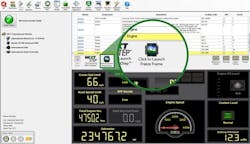Tech Tip: Utilizing freeze frame data
Freeze frame data is data produced by a vehicle component – often an Engine Control Module – that is automatically stored based on the occurrence of a fault. Basically, if an active fault occurs from the engine, it triggers a freeze frame event which saves date and time information for the first and, when applicable, last occurrence of the fault. Think of freeze frame data as breadcrumbs that help a technician understand the vehicle’s state when a fault occurred to assist with diagnosing the problem.
A crucial part of a technician’s job is to verify the complaint of the customer in order to make an accurate diagnosis and repair the root cause of the issue. Part of verifying the customer complaint is to establish when the issue occurred on the vehicle. The technician must use all available data to confirm if the driver or vehicle owner detected the issue in conjunction with it occurring, or with some length of time passing, to best understand the conditions leading up to the problem developing.
Freeze frame data is often an essential clue in solving intermittent issues. Some equipment manufacturers capture more data than others during freeze frame events, but technicians should use any available information to help fill gaps in the diagnostic puzzle. If a customer complains of a check engine light briefly illuminating three times in the past week, freeze frame data may lend information to help determine what is unique about the occurrences. For example, is the vehicle traveling a certain speed when the light is triggered? Is it during the middle of the afternoon while the truck is sitting in traffic in heat? Time of day can often be an indicator that helps the technician begin the diagnostic process.
When freeze frame data is available for a particular fault in JPRO, the Freeze Frame Parameters icon becomes available on the screen. Clicking on the icon brings up the associated data for the selected fault.
Pairing freeze frame data with JPRO’s fault history is an advantageous method for technicians to diagnose issues. Historical fault data, which is stored only from previous JPRO connections and not the component’s internal history, helps users understand if similar faults occurred previously on the vehicle, and when paired with freeze frame data, can help determine if similar vehicle issues in the past led to the same problem.
Determining the root cause of a problem is imperative to making a long-term fix, rather than applying a temporary solution that will allow the problem to fester or reoccur. Technicians should use all tools and resources available to learn what is causing an issue and freeze frame data is one of the many resources that can often provide the missing part of the equation.
Information provided by Noregon Systems, Inc.
